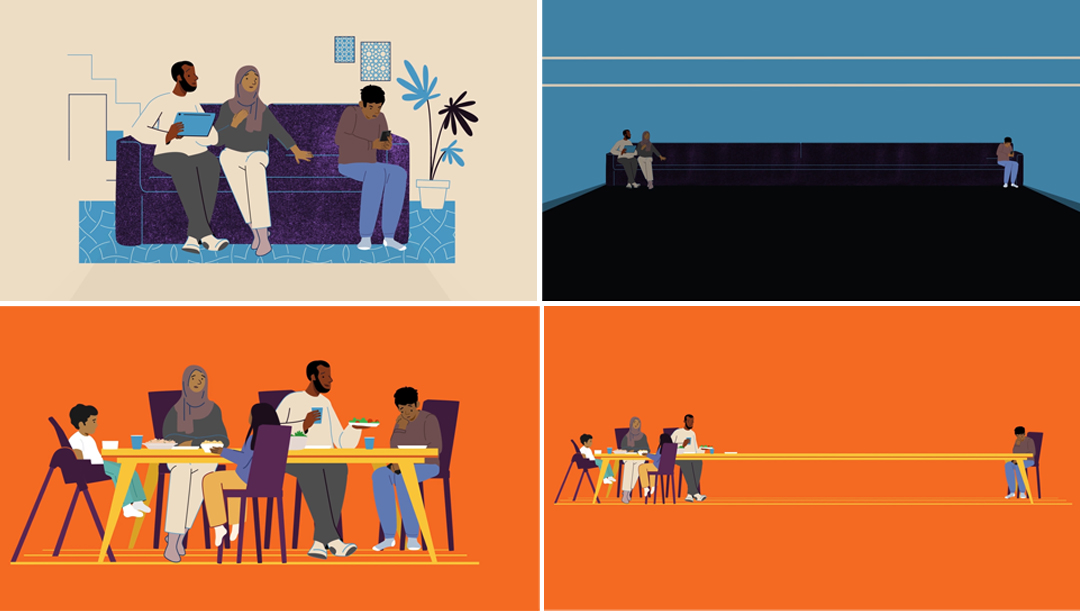NSPCC: (Un)comfortable Conversations
This dialogue-free explainer animation created for the NSPCC, harnesses the power of expressive animation to tell a compelling story, without the need for any words.
NSPCC commissioned this animation to promote their existing guidance materials titled (un)comfortable conversations. The guides support Muslim families to have important discussions with their children about difficult topics, in a way that’s age-appropriate, culturally sensitive and supportive.
No problem!
But did we mention… the main requirement of this brief which focused on encouraging conversation, was to avoid using any language... at all! This would enable the messaging to reach the widest possible audience, specifically those with English as a second or third language. It also meant we needed to use all our illustration and animation skills to narrate a detailed story, with no words! Here's an overview of how we went about doing it.
Visual Storytelling
As part of NSPCC’s brief, they’d already created a narrative which aligned with their wider campaign. The scenarios featured a Muslim boy and his family, struggling to communicate with each other. We developed this narrative and created detailed direction which would be vital when moving onto storyboarding.
Character Design
Designing the family was the first step. We instinctively knew the characters should not be too cartoony and have realistic proportions. This created a seriousness to their designs which grounded the story in reality. Making them relatable to the viewer.

With the animation focused towards Muslim families, we also worked closely with NSPCC to make sure styling, settings and any relevant props accurately captured the right cultural detail.
Setting the Scene
Our characters were placed in simplified background settings that included hints of Arabic design and Muslim culture. The backgrounds featured enough information to convey location while retaining a stylistic aesthetic to the design. We also created some scenes with dramatic lighting and texture to communicate moods and build visual tension. All of these elements added vital layers to the storytelling.
Even more emotion was created at key moments, by dramatically stretching the backgrounds apart. Without dialogue, this design feature illustrates tension, despair and separation between the family and the son.

In turn, reversing this stretch ultimately shows the gap closing between the family as the conversation starts to flow towards the end.
Animation
We used our fully illustrated storyboard to create a detailed animatic. This stage was vital to make sure the storytelling was clear, and there were no obvious gaps in the implied narratives.
Working with no dialogue meant we approached animation slightly differently to usual. Normally when we have a voiceover, animation reinforces the narrative rather than creating it. Conversely, without a voiceover, the focus shifts to the characters' emotions, drawing viewers deeper into each scene and prompting them to interpret the unfolding events independently. For this reason, the illustrations and timing were the pillars of our storytelling.
Timelapse character animation
We made sure each moment had just enough time to breathe and every character movement was crafted with purpose.
Moving through the scenes too quickly created a detached feeling, so the timing, accuracy of poses and expression were the most important aspects to get right.
Sound design
We never underestimate the power of sound design to bring a narrative to life, especially one with no words. Adding a gently evolving musical composition and sound effects that reacted to mood and movement was integral to establishing an emotive story.
Wordless Storytelling
Producing a film about conversations, where no conversations were heard, was certainly one of our tougher briefs. However, it reminded us how powerful visual storytelling can be and how much we love crafting this style of communication. Especially when it gives freedom to the viewer; allowing them to interpret scenarios into personal narratives of their own.
